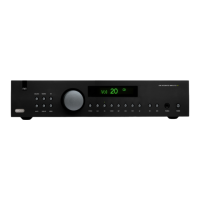Audio inputs
Although the inputs are labelled for specic devices, all
have the same characteristics and each may be used with
any line-level product. e exception is the optional
Phono input (see page 16 for specication).
DVD
Intended for the analogue outputs from a DVD-player.
AV
Intended for the analogue outputs from general audio-
visual equipment, such as a VCR, digital TV/satellite
receiver, or Nicam tuner.
TUNER
Intended for the analogue outputs from a radio tuner.
CD
Intended for the analogue outputs from a CD player.
AUX
is is intended for general use. Connect the analogue
audio outputs of any unit with a line-level output (such
as a games console or set-top box).
Recording loops
e A38 is equipped with two recording loops, for use
with recording devices (such as cassette decks, CD
recorders, DAT recorders, VCR, PVR etc.).
AV RECORD OUT
Connect these output sockets to the input sockets of
your recording device (usually labelled RECORD or IN).
AV PLAY IN
Connect the output sockets of your recording device
(usually labelled P LAY or OUT) to these inputs.
If you do not have a recording device, you can use this
input for other (line-level) equipment, such as a TV,
DVD, CD-player, radio tuner, PVR, etc.
PVR RECORD OUT
ese output sockets can be connected to the input
sockets of a second recording device.
PVR PLAY IN
Connect the output sockets of your second recording
device to these inputs. Alternatively, this input may be
used for other (line-level) equipment such as a games
console, set-top box, etc.
AV Dubbing
You can perform tape dubbing from PVR to AV, but not
from AV to PVR.
For example, to copy from a cassette recorder connected
to the PVR socket, to a cassette recorder connected to the
AV socket, rst use the RECORD button to select ‘Record
PVR’. is routes the PVR signal to the AV output.
Phono input
As standard, no phono input is tted to the A38.
e phono module (or an external phono amplier) is
required if you wish to connect a record player to the
A38. is is because the low-voltage output of a record
player requires a pre-amplication stage before the signal
can be used.
A very high quality phono input is available as an optional
extra: please consult your dealer for price and availability.
e Arcam phono module is compatible with moving-
magnet cartridges (MM) and moving-coil cartridges
(MC). Once the module is tted, you should select MM
or MC via the recessed MM/MC back panel switch (push
the switch in for MC).
If you have already an external phono amplier that you
wish to use, connect this to one of the line-level inputs,
such as the AUX input.
Controlling A38 from a second room
e A38 will require a remote pick-up device with a 12V external power supply
(such as a Xantech Dinky Link) located in Zone 2, together with a power amplier
(such as an Arcam A38 or P38) to complete the system.
e diagram below shows the wiring scheme, which will also apply to other IR
pick-up devices commonly available.
e A38 can also provide a +12V trigger output to control devices such as the
power amplier in Zone 2. e +12V trigger is active when the unit is ‘On’.
Signal
Tip = Signal
REMOTE IN
Dinky Link, located in Zone 2
Sleeve = 0V
Pre-/power-amplifier connections
PRE OUT
To use your A38 as a dedicated pre-amplier, or as part
of a bi-amp’ed system, connect the PRE OUT sockets to
the input sockets of your power amplier.
PWR IN
To use your A38 as a power-amplier, connect the
output of your pre-amplier to the PWR IN sockets.
If you wish to use your A38 as a dedicated pre- or
power-amplier (but not in the case of a bi-amp’ed
system), press the PRE/PWR switch in on the rear panel.
is separates internally the connection between the
pre- and power-amp. stages of the A38.
When used as a power amplier, your A38 has exactly
the same specication and performance as a P38,
described later in this handbook.

